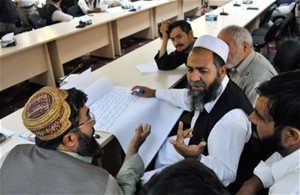
Afghan turbine manufacturers from across the country engage in group discussions during a needs assessment workshop held at the Ministry of Rural Rehabilitation and Development.
Ian Carver, ACEP
Turbine manufacturers discuss challenges and expectations at needs assessment workshop.
The plan is to identify priorities and prepare a master list that can be presented to USAID to decide what areas need funding or technical assistance.
15 SEPTEMBER 2010 | KABUL, AFGHANISTAN
In Afghanistan, serious power shortages have prompted a return to traditional biomass and imported hydrocarbon fuels for lighting, cooking and heating. Restoration and upgrading of micro hydropower plants seems to be a better solution. However, there is a lack of quality turbine manufacturing capacity and qualified experts needed to achieve this. Recently, the Ministry of Rural Rehabilitation and Development (MRRD) supported by the USAID’s Afghanistan Clean Energy Program (ACEP) held a workshop for Afghan turbine manufacturers to identify and address key challenges and constraints faced in this sector.
“Afghans should benefit from quality products, which impact living conditions,” said Wais Ahmad Barmak, Deputy Minister of MRRD. “We need a plan to identify the capacities, strengths, and gaps in this sector to decide the best next steps.”
The National Solidarity Program, Energy for Rural Development of Afghanistan and ACEP delivered presentations covering the role of the private sector as a service provider for micro hydropower plants, production of various turbines for use in Afghanistan, and the hydropower engineering experience in Nepal, whose geography is similar to Afghanistan.
After the presentations, participants discussed their needs and priorities, barriers to improving the capacity of turbine production, and their expectations, which included on-the-job training on the construction of advanced turbine models.
A major workshop highlight was the expressed desire by participants to form a turbine manufacturing association, which could serve as a forum to pose questions and voice pressing issues and to seek advice and training opportunities.
“The workshop was a very good opportunity to hear from others,’ said Mohammad Hamini, a cross-flow turbine manufacturer from Herat province. “If we have more of these kinds of workshops, it will be very beneficial to our work and we will be most grateful.”







Comment
Make a general inquiry or suggest an improvement.